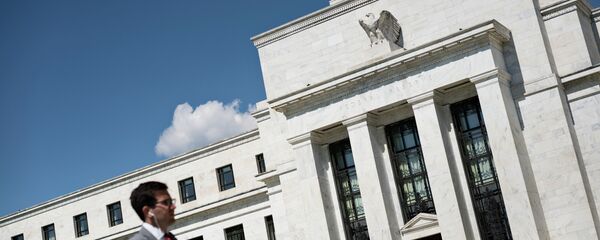Kristian Rouz — As part of return to ‘normalcy' in their monetary policies, the US Federal Reserve issued a disclaimer warning of the looming and inevitable cancellation of the overnight repurchase facility (ON RRP), known as the ‘overnight repo.' The planned move will reflect negatively on market valuation of ‘government-only' money funds, which are now seen by investors, money management firms and the broader market as more stable and reliable than once-flourishing ‘prime' money funds.
The Fed had to warn the market amidst an unprecedented conversion of capital from ‘prime' to ‘government only' in more than 100 money funds using the ON RRP tool, providing short-term liquidity at a 0.25% interest rate.
As base borrowing costs are now set by the Fed at 0.25-0.5% level, ON RRP is currently one of the cheapest ways to borrow, meaning higher demand for the scheme from both foreign and domestic commercial borrowers since the December hike in rates.
What the funds have been doing increasingly in the recent two months is diverting capital from investing into a broad gauge of stocks, bonds and other securities, in favor of the governmental tool. Consequently, significant volumes of money, instead of going to Wall Street generating profits on the terms of open market, are flowing into the more profitable and in-demand governmental borrowing tool, issuing cheap loans. Partially, that might have contributed to the ‘bloodbath of red' on Wall Street in January: a lion's share of investment capital would be converted into cheap loans to foreign and domestic borrowers instead of being invested in stocks.
The ON RRP might be revoked as soon as in October, when the US Securities and Exchange Commission (SEC) will have to determine whether to extend or terminate the scheme. As the Fed are likely to have hiked borrowing costs even higher by then (to at least 0.5-0.75% should at least one hike happen in the meantime), the mechanism of lending at a 0.25% rate would undermine the regulator's policy efforts and goals, as it would allow to circumvent the overall tighter monetary conditions.
"This could possibly lead to less efficient transmission of monetary policy," Simon Potter of the New York Fed said. "We would not want to see growth in government-only money funds if it were predicated on a mistaken impression that ON RRP would be around indefinitely and with high capacity."
On 16 December, a day before the liftoff in borrowing costs, the Fed removed its reverse repo limits of $30 bln per day in order to obtain a harder grip on interest rates, having simultaneously raised repo rates to 0.25% from 0.05% in line with the broader monetary tightening.
Meanwhile, the use of foreign repo tools is on the rise as well. Nations like mainland China and Japan, dumped US Treasuries earlier this year to support their currencies FX rates and put their dollar-denominated liquidity into the Fed repo tools, killing two birds with one stone: their money is still in the US, while the dollars they use to support their FX rates come from liquidity borrowed from the US Fed.
"They have been selling their Treasuries holdings and using more the Fed's reverse repo program. It's a place where they could park their cash for a period of time until they decide what they want to do with it," Alex Roever of JP Morgan Securities said.
The Fed's foreign repo rate is estimated at 0.33-0.35%, while domestic repo rate is 0.25-0.26%.
"There is an interest-rate incentive for foreign central banks to take deposits from commercial banks and park those moneys in the foreign customer pool at the Fed," Raymond Stone of Stone & McCarthy Research Associates said.
Consequently, should the US SEC revoke select repo tools, their users will lose significant amount of money, which will reflect on their market performance. For the US-based entities that means decline in listed stocks and overall financial market fever similar to that seen in January, only larger in scale.
For foreign entities that will likely mean a crash in currency devaluations and harder economic shake-up stemming from loss of central bank money-management credibility.





